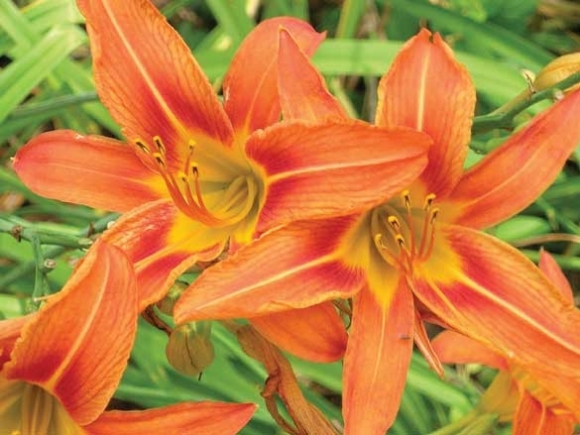The day lily is a beautiful, hardy outlander

How many naturalized plants do you recognize from your vehicle this time of year as you drive around taking care of business? My guess is that it’s more than you might anticipate. By “naturalized,” I mean those that were deliberately introduced as medicinals, edibles, ornamentals, etc., but have “escaped” from cultivated situations and become part of our regional or national flora. Some of these — like kudzu, privet, multiflora rose, etc. — are so invasive we’d just as soon they went on back to where they came from.
Some, however, are a welcome addition to our Western North Carolina flora. My favorite in this regard is the old-time daylily rusty-orange species (Hemariocallis fulva). Few plants are so graceful and harmonious as they arc in cascades over roadside embankments or silently mark the sites of gardens and homes long since forgotten.
No longer classified as a true lily, daylilies are perennial plants whose generic name alludes to the flowers, which typically last no more than 24 hours. Native to Eurasia, the genus is popular worldwide because of the showy flowers, ease of care, general hardiness, culinary uses (all parts of the plant are edible), and use as cut flowers in floral arrangements in which new flowers continue to open over several days.
There are many thousands of daylily cultivars of every size and color combination imaginable. My favorite has always been the old-time reddish-orange species that the earliest settlers from Europe brought to the New World and the pioneer settlers of the southern mountains moved farther inland. It’s fondly known by enthusiasts as the “trash pile lily” because it will thrive even after being uprooted and tossed onto the garbage heap.
For years no home garden in WNC featured daylilies more colorful and varied than those at Dixie and Tommy Hughes’ place several miles west of Bryson City. Dixie and Tommy have both passed away in recent years, but in its heyday Dixie’s garden featured 70 daylily varieties that provided an eye-catching mosaic of shapes, sizes and colors designed to bloom from early June into early fall.
Of growing daylilies, she had this to say: “They don’t require a lot of care. Just keep the high weeds down and dig and separate them from time to time. Most winters they don’t need any protection. If you choose the right varieties, you can have them in three seasons in a variety of colors. You’ll always be running upon a new color or shape you don’t have.
Related Items
“They have a long history that makes them interesting. I see them in the backwaters of the national park when we go back in around Chambers Creek to visit the old home places and cemeteries. They’ve been there alone for 55 years now and are doing fine just taking care of themselves.”
George Ellison is a naturalist and writer. He can be reached at This email address is being protected from spambots. You need JavaScript enabled to view it..









